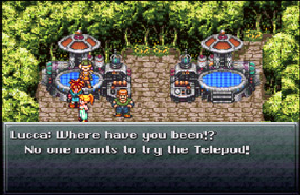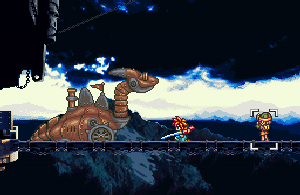 Review: Chrono Trigger
Review: Chrono Trigger

J-RPG
Square’s classic finally arrives fourteen years late.
![]()
Mark
Now in Europe (and other PAL territories like Australia) we’re used to Nintendo taking the piss when it comes to release dates. They’ll often delay the release of a game for months or sometimes even years in the case of ‘Professor Layton and the Curious Village’ seemingly for no reason other than pure sloth or the good old European muti-lingual demographic excuse. However, all these recent delays pale in comparison to this game which has been waiting for a Euro release for the best part of fourteen years. I’ll just repeat that for anybody speed reading… fourteen fucking years.
If the game in question was some obscure horse racing simulator or other low profile title it could be excused. But when the game in question is a serious contender for the best RPG ever award and is often mentioned in the same breath as truly great games like Final Fantasy VI the delay is almost unforgivable. So it’s a good job that the game is not just one of the best RPG ever made but also the best DS game released yet. Again for the benefit of speed readers… best DS game ever. Which given that it’s an updated SNES game says a lot about the quality (or lack of) most DS games released.

One word: Brundlefly.
Chrono Trigger is a 2D top-down viewed RPG that looks and plays a lot like the SNES era Final Fantasy games which is no great surprise as it had both Final Fantasy creator Hironobu Sakaguchi, composer Nobuo Uematsu and a few Dragon Quest designers working on it. The story has the hero Crono travelling between different time periods to fight evil and then attempt to prevent the awaking of an extraterrestrial parasite. You’ll have a party of three members which you pick from a group of up to seven playable characters with each having their own special abilities, magic type and various strengths and weaknesses.
From there you’ll follow the different plots and sub-plots that’ll have you jumping from the cave dwelling past to the far flung future dealing with the different paradox problems such as meeting your ancestors and having to contend with people or places not yet existing in the timeline or having been removed by prior incidents. A good example of this being your early actions in the game’s first section that are later replayed to you while on trial. So if you adopt the normal RPG attitude of taking everything you find and ransacking chests be prepared to be accused of theft.

Didn't you used to be under the stairs in Rentaghost?
Of course being that the game’s an RPG it’s not all talking and exploring there’s also tons of combat which thankfully can be avoided if you dodge enemies on the world map and while in dungeons and the like. The battles are played out with an active time system that encourages teamwork with combo attacks using two or all three of your characters having far better effects that trying to go solo. Many enemies also have counter-attacks or team attacks so choosing when not to attack is just as important as knowing their elemental weaknesses or weak spots.
Each character has a set number of hit points and magic points that represent their health and ability to cast magic spells or perform special attacks and the like. Access to new techniques and additional HP/MP are gained by collecting experience in combat which also increases the character’s overall level with later levels having advanced techniques and powerful spells. Nothing about the combat is (was?) revolutionary it all works and plays like you’d want it to, with the simple inclusion of being able to avoid random encounters and dodge hostile enemies making it a far less frustrating than say Final Fantasy with its near constant cycle of walk-fight-walk-fight-walk-open chest.
|
Matthew Secondary Review So after almost fourteen years we finally see the release of what is considered by many as the greatest RPG of all time. Despite the fact I generally can’t be arsed with any J-RPG that isn’t Pokemon, I was eager to play this. The main feature that I usually despise about these games is the random battles but thankfully there is none of that nonsense here. Enemies appear on the screen and you sometimes have the opportunity whether to avid them or not, and it uses an active time battle system which I much prefer over the standard turn-based system. When I fired the game up I was impressed with how the game still holds up well today – both in terms of visuals and sound. The vibrant colours and 16-bit sprites have survived the test of time and some of the level backdrops in particular are stunning. The soundtrack is timeless and helps to evoke atmosphere throughout the game, it’scertaily worth picking up as you can find it. Obviously with this being a DS game the touchscreen is put to good use. You can choose to play the game in its original classic form, or the new version which displays all of your battle options on the touchscreen and offers easier access to command. You can also use the touchscreen, rahter than the d-pad, for movement but it feels rather imprecise and a little clunky. It works great for everything else though. The best part of the game for me is without a doubt the story and it’s colourful cast of characters that join your party along the way. The whole time travel theme of the game is fantastic, from the prehistoric 12,000 B.C. to post-apocalyptic 2300 A.D. It’s interesting to see familiar locations have changed throughout time and how your actions in the past affect future events. While the game’s length isn’t probably as long as you would expect, there are many incentives to replay – multiple endings, a new game + mode plus all the new additions such as the monster arena. Quite simply this game needs to be bought, not only if you are a fan of RPGs, but a fan of gaming. Secondary Score: 8/10 |
Unlike many RPGs there’s no big gimmick or fancy pants system used to try and make it stand out from the RPG crowd and the J-RPG crowd in particular. The characters are all likeable and unique from the noble Frog, geeky Lucca and brash Crono. The story is well written and surprisingly deep yet has many moments of levity and humour which are so often missing in this most po-faced of genres.
The game’s dialogue has been translated anew making in less clunky compared to the old SNES version that was shackled by prudish Nintendo of America censorship guidelines and a rushed translation.
Best of all the added DS functionality is all very practical with no new pointless stylus rubbing or mic blowing needed and the dual screen layout used as you’d want it to be with the action on the top screen and inventory, techniques and other important information displayed on the lower screen. You can view destroyed enemies and found items in the game’s encyclopaedia, browse concept artwork as well as re-watching the FMV segments and even listening to the amazing music by genius composer Nobuo Uematsu. Add to this a Wi-Fi battle arena not to mention the multiple endings in the game itself and you have an amazing game with masses of longevity and replay value.
Sure the fabled ‘Radical Dreamers’ semi-sequel isn’t included still leaving it only available to those willing to use illegal emulation to play it and the new bonus dungeons are uninspired compared to the main quest, but marking down the whole Chrono Trigger package for one duff section and the non-inclusion of something only the hardest of hardcore otaku would miss would be a almost as bad as the wait we’ve had to endure to (legally) play this game.
At long last someone has finally produced a piece of truly indispensable software for the DS. There’s a great core game to play and replay with just enough DS functionality to enhance the experience without resorting to pointless gimmickry or mini-games. If more classic games where treated as well as this, retro titles could easily stand side by side with contemporary releases rather than being forced to one side by short sighted publishers hoping to wring a few more shekels from old intellectual properties.
Rating: 









10/10
